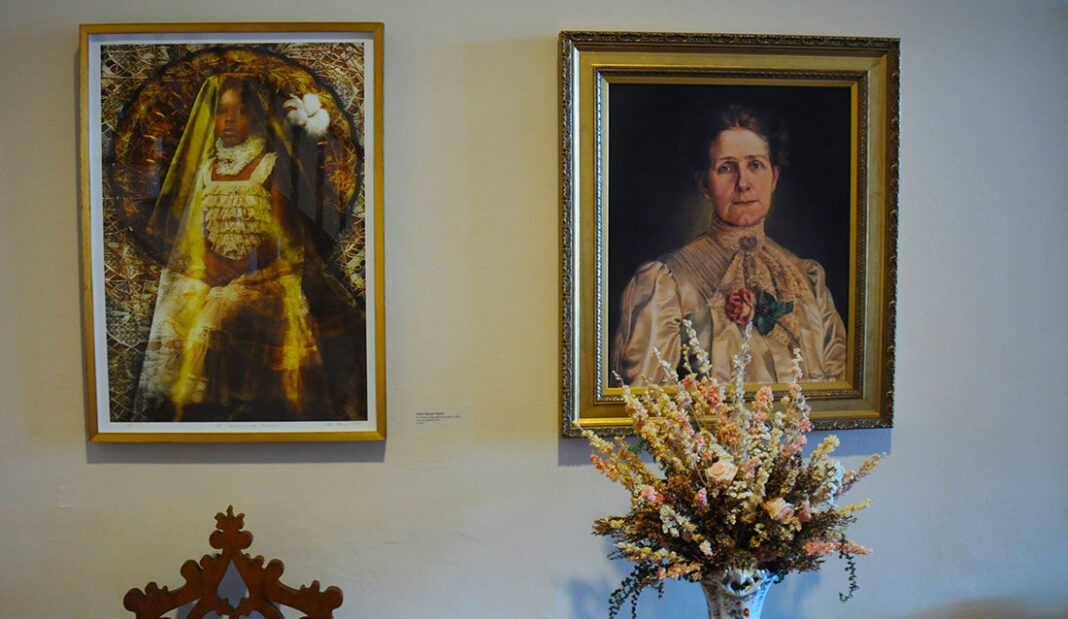Exploring “Interwoven Narratives: Caul and Response” at the Lyndon House Arts Center
Step into the West Gallery of the Lyndon House Arts Center to witness a captivating blend of texture, folklore, photorealism, and abstract expressionism crafted by twin sisters Sachi Rome and Tokie Rome-Taylor. Their latest exhibition, “Interwoven Narratives: Caul and Response,” intricately weaves themes of birth, death, identity, and history through a rich tapestry of mixed-media works that incorporate photography, textiles, and natural elements like beeswax and botanicals.
The Symbolism of the Caul
The term “caul” in the exhibition’s title draws on deep roots in symbolism and folklore from diverse cultures. In rare instances, a baby is born enveloped in a caul, an amniotic membrane covering the head and face. This can be safely removed and is often kept for its perceived protective qualities. The belief that being born with a caul—or “veil”—imparts supernatural or prophetic abilities is prevalent in many African and African American traditions.
W.E.B. Du Bois notably refers to this idea metaphorically in The Souls of Black Folk, where he describes a veil that separates African Americans from the freedoms and privileges enjoyed by white society. Du Bois articulates that the African American, “born with a veil,” is endowed with a unique perspective on the world, one that often leaves them grappling with their identity in a society that marginalizes them.
Artistic Expression of the Veil
Both Rome and Rome-Taylor manifest this symbolic veil in their artworks. They create layers of embroidery, beeswax, pigments, and other materials atop photographic prints, forming a kind of membrane between the viewer and the artwork. The abstract textures often obscure the faces of the subjects, creating an atmosphere of uncertainty and mystery, alongside an underlying desire for revelation. The silhouettes of figures are adorned in hues reminiscent of nature—ocean blues, autumn oranges and yellows, clay reds of Georgia, and soft whites—often depicting somber expressions, particularly among child subjects. In contrast, some pieces are wholly abstract, as if representing the veil itself, both present and elusive.
Double Consciousness in Focus
Another poignant connection to Du Bois is the notion of double consciousness. He eloquently captures the sensation of viewing oneself through the perspective of others, which often measures one’s existence against a backdrop of societal contempt and pity. This idea is essential to understanding the emotional and psychological layers present in “Interwoven Narratives.”
The cover artwork featured in this week’s edition of Flagpole, titled “Communing with the Ancestors,” speaks directly to this intricate idea. It portrays a young Black girl enveloped in lace and pearls, holding a Black doll. Her calm yet somber expression, accompanied by a downward gaze, evokes contemplation. Adorning her neck is a collar reminiscent of Elizabethan portraiture, often linked to wealth and purity in European culture. In this striking portrayal, the girl appears both enveloped and restrained by the finery, while the doll, swaddled within the same ornamental veil, highlights the protective and complicated nature of heritage.
Call and Response: A Cultural Dialogue
The exhibition’s title also alludes to the African diasporic tradition of call and response. Many West African ceremonies are characterized by a rhythmic exchange between a leader and a group, creating a collective memory that honors ancestors and connects the earthly to the spiritual. In the gallery setting, this dynamic transforms the viewer into a participant—where the art “calls” out, and the viewer is encouraged to “respond” through reflection and engagement.
Recognition of the Artists
Both artists have garnered acclaim across various institutions. Rome-Taylor’s work is housed in the collections of notable establishments like MOCA GA, the Fralin Museum at the University of Virginia, and the Southeastern Museum of Photography. With an extensive exhibition history that includes the Atlanta Contemporary and international venues like SP-Foto SP-Arte in São Paulo, Brazil, she also serves as an educator challenging the norms of photographic storytelling.
Similarly, Sachi Rome boasts a notable exhibition record throughout the Southeast, including venues such as the University of Southern Mississippi Museum and the Hammonds House Museum. She has received numerous awards and residencies recognizing her contributions to the arts and has been featured in the publication Shifting Time: African American Artists 2020–2021, spotlighting contemporary African American art.
A Meditation on Identity and Experience
“Interwoven Narratives: Caul and Response” serves as a contemporary meditation on memory, identity, and self-reflection. Drawing on folklore, history, and personal experience, Rome and Rome-Taylor invite viewers to consider the nuanced ways identities are both shielded and revealed, felt and seen. Their artworks create a rich material exploration of African American experience—before, within, and beyond the veil.
This exhibition will remain on view until January 24. An artist talk is scheduled for Thursday, November 13, at 5:30 p.m. at the Lyndon House Arts Center, offering deeper insight into the creative processes of these talented artists. For more information, visit accgov.com/lyndonhouse.
Event Details:
- What: Artist Talk
- When: Thursday, Nov. 13, 5:30 p.m.
- Where: Lyndon House Arts Center
- Cost: Free!
For anyone interested in a blend of culture, art, and history, this exhibition promises to be an enriching experience that challenges perceptions and encourages dialogue surrounding identity and heritage.



